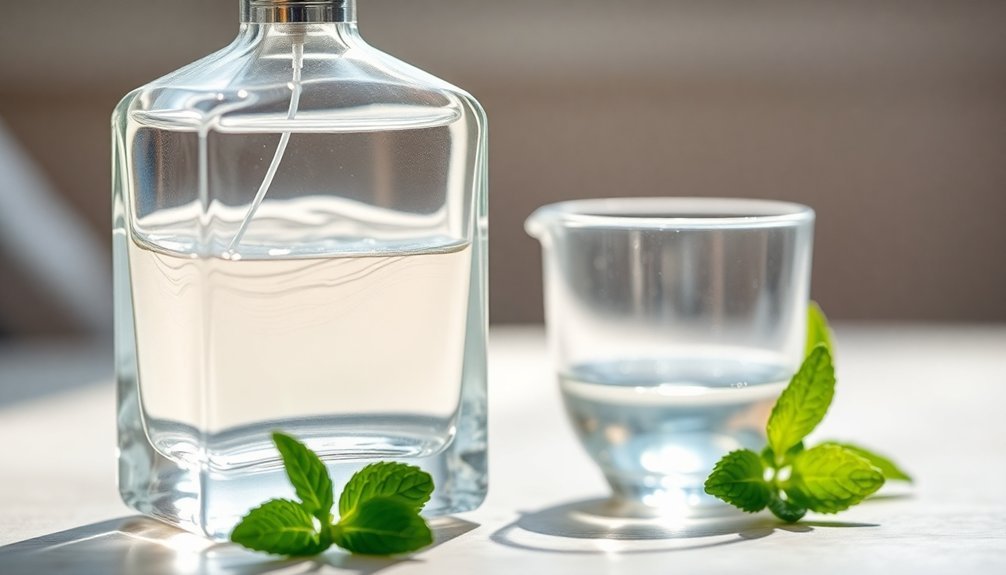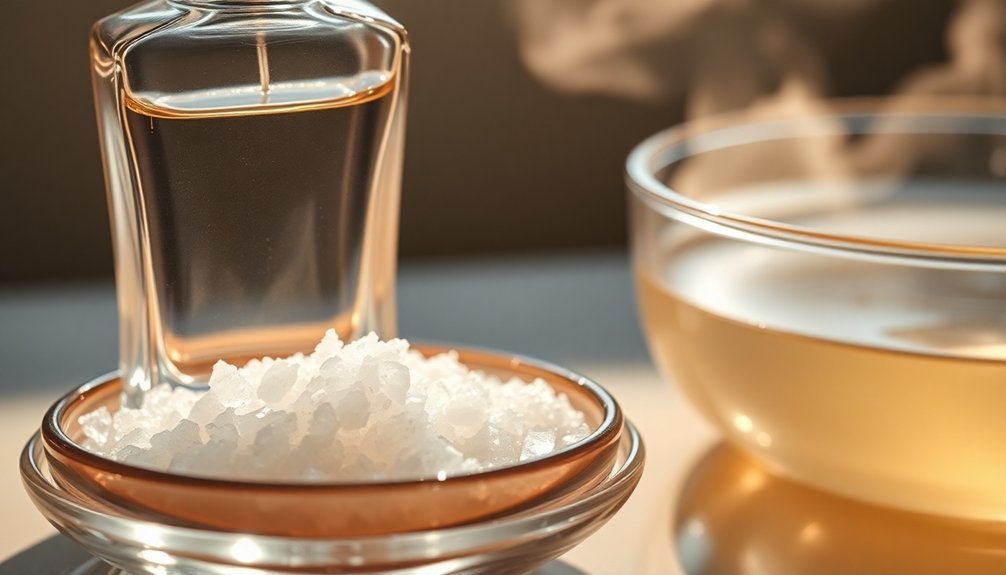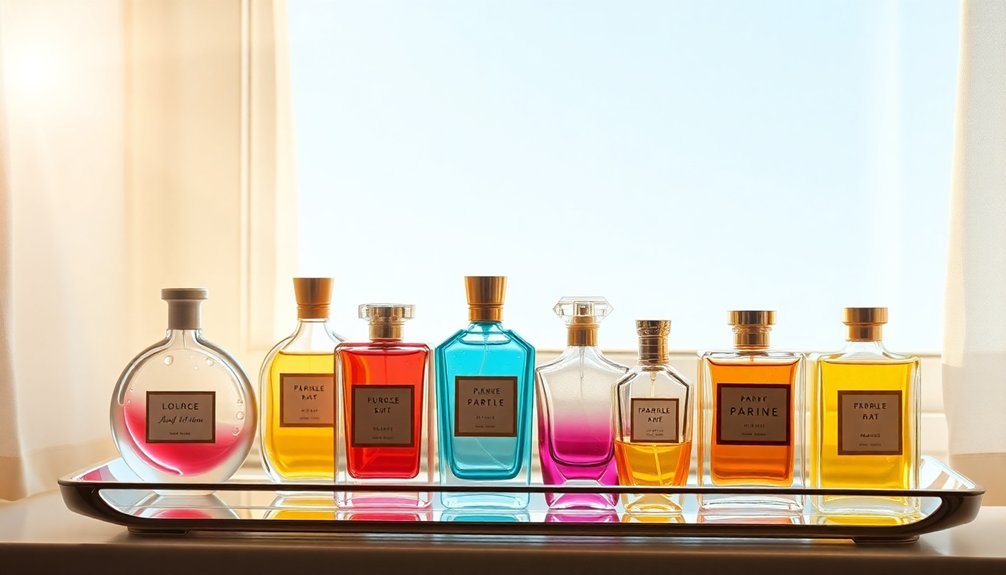Keep your perfume bottles pristine with seven proven cleaning methods. You'll find success using equal parts vinegar and warm water, or try gentle scrubbing with rice and soap. Salt solutions work well for deep cleaning, while isopropyl alcohol tackles stubborn residues. Cotton swabs help with intricate designs, and proper air-drying guarantees lasting results. You can also use natural cleaners like essential oils and baking soda. These safe techniques will transform your bottle collection's appearance and reusability.
The Vinegar and Water Method: A Natural Cleansing Solution

When it comes to cleaning perfume bottles, a simple mixture of equal parts white vinegar and warm water provides a safe and effective natural solution.
You'll find this gentle cleanser works particularly well on glass, crystal, and even plastic bottles without risking any damage to their surfaces.
To use this method, combine the vinegar and warm water, then pour the mixture into your perfume bottle.
You'll want to let it sit for at least an hour to allow the solution to break down oils and residue effectively.
While waiting, give the bottle a gentle shake to guarantee the mixture reaches all areas.
Make sure to carefully drain any leftover perfume before beginning the cleaning process.
This chemical reaction naturally dissolves stubborn stains without the harsh effects of strong solvents.
Once done, rinse thoroughly with warm water and dry with a lint-free cloth.
Using Rice and Soap for Gentle Scrubbing
When you're ready to clean your perfume bottles, combining uncooked rice with mild dish soap creates an effective yet gentle scrubbing mixture.
You'll want to add just a teaspoon of each ingredient to warm water, ensuring the rice can move freely within the bottle to reach all surfaces.
The rice acts as a natural abrasive that won't scratch your bottles, while the soap helps break down stubborn residues and oils.
Remember to shake gently when using this mixture to optimize the cleaning power without risking damage to your bottles.
Rice Mixture Best Practices
Three key ingredients – uncooked rice, mild dish soap, and warm water – create an effective and gentle cleaning solution for perfume bottles.
You'll want to combine these elements carefully to achieve the best cleaning results while protecting your delicate bottles.
- Start with a small amount of uncooked rice (about 1 tablespoon) and add just enough warm water to cover the bottom of the bottle. This method is safe for bottles since it avoids harsh chemicals that could cause damage. Add a few drops of mild dish soap, then gently swirl the mixture.
- Let the solution sit for 5-10 minutes to help break down stubborn residue, then shake gently to allow the rice to scrub all interior surfaces.
- Rinse thoroughly with clean water until all soap and rice are removed, then air dry completely to prevent moisture buildup.
Natural Scrubbing Without Damage
Since perfume bottles require delicate handling, natural scrubbing techniques provide the safest way to clean without risking damage to the glass or decorative elements.
You'll want to start with a gentle soap solution mixed with warm water, adding a small amount of uncooked rice as your natural abrasive agent.
Gently shake the bottle with this mixture, allowing the rice to act as a soft scrubber against residue and buildup.
For intricate designs or hard-to-reach areas, use a soft-bristled toothbrush to carefully clean without scratching the surface.
Don't forget to pay special attention to fragile engravings, using extra care around decorated areas.
Once you're done scrubbing, rinse thoroughly multiple times to remove all soap residue, and let the bottle air dry upside down.
Warm Water and Salt: Deep Cleansing Technique

Although many collectors focus on displaying their perfume bottles, proper cleaning is vital for maintaining their beauty and value. The warm water and salt cleansing technique offers a gentle yet effective way to deep clean your cherished pieces.
You'll need basic supplies like warm water, salt, and a soft cloth, along with tools such as a basin and bottle brush.
- Begin by removing labels and dissolving salt in warm water, then fill your bottles and let them soak overnight.
- Use a bottle brush to scrub the interior, and wipe the exterior with a soft cloth.
- For stubborn residues, add white vinegar to your cleaning solution, then rinse thoroughly and air dry completely.
Remember to avoid harsh cleaners and always guarantee bottles are completely dry before refilling.
Isopropyl Alcohol Method for Stubborn Residue
When traditional cleaning methods fall short, isopropyl alcohol provides a powerful solution for removing stubborn residues from perfume bottles.
You'll need either 70% or 99% isopropyl alcohol for this method. Start by removing the bottle's cap and any other detachable parts.
Fill the bottle with alcohol, leaving enough space for shaking, and let it soak for several days. While soaking, shake the bottle periodically to guarantee the solution reaches all surfaces.
For best results, fill and soak the bottle with alcohol for several days, periodically shaking to ensure complete coverage.
For particularly tough residues, use a bottle brush to gently scrub the interior.
Once you're satisfied with the cleaning, empty the alcohol into a container for reuse or disposal. Rinse the bottle thoroughly with warm water and let it air-dry in a well-ventilated area before using it again.
Cotton Swab Technique for Intricate Designs

You'll need cotton swabs dipped in a gentle mixture of white vinegar and water to effectively clean your perfume bottle's intricate patterns and hard-to-reach areas.
To prepare your cotton swabs, make certain they're not overly saturated with the cleaning solution, as excess liquid can seep into unwanted areas of the bottle.
Using gentle circular motions with the cotton swab, you can meticulously clean detailed engravings and tight corners while protecting the bottle's delicate surface from damage.
Reach Tight Corner Areas
Intricate perfume bottles with delicate designs require special attention during cleaning, particularly in their hard-to-reach corners and crevices.
You'll need precision tools like cotton swabs to effectively clean these areas while protecting the bottle's delicate features.
- Dip a cotton swab in a gentle mixture of white vinegar and water to clean tight spots without risking damage from harsh chemicals.
- Secure your bottle on a stable surface before cleaning to prevent accidental drops while you're working on detailed areas.
- Keep moisture to a minimum when cleaning around metal or decorative elements to avoid potential damage or tarnishing.
Remember to use small brushes for detailed patterns and always check the bottle's material before selecting your cleaning method.
This careful approach will help maintain your bottle's beauty while ensuring a thorough clean.
Cotton Swab Preparation Steps
Three essential steps guarantee proper cotton swab preparation for cleaning delicate perfume bottles.
First, mix your cleaning solution by combining equal parts white vinegar and water, or prepare a mild dish soap solution – choose based on your bottle's material sensitivity. You'll want to have several cotton swabs and a soft, lint-free cloth ready.
Next, dip your cotton swab into the solution, making sure it's damp but not dripping. You don't want excess moisture that could damage decorative elements or leave water spots.
Finally, test the solution on a small, hidden area of your perfume bottle to verify it won't harm the surface. Remember to replace your cotton swabs frequently during cleaning to prevent dirt transfer and maintain effectiveness.
Detailing Without Bottle Damage
When cleaning ornate perfume bottles, delicate designs require extra attention to prevent scratches and damage. Use cotton swabs with a light touch, making gentle circular motions to access intricate patterns and engravings without causing harm.
You'll want to keep the swab slightly damp, not soaking wet, to protect metal components and prevent water from seeping into sensitive areas.
- Work systematically around detailed areas, using the cotton swab's tip to reach into crevices and clean accumulated residue.
- Pay special attention to etched patterns and raised designs, applying minimal pressure while maintaining consistent circular movements.
- Switch to a fresh cotton swab frequently to avoid spreading dirt and guarantee you're always cleaning with a clean surface.
The Air-Dry and Sunlight Method

Although cleaning perfume bottles requires careful attention, the air-dry and sunlight method offers a safe and effective approach to guarantee your bottles stay pristine. You'll need to empty and rinse the bottle thoroughly with warm water, then use a soft brush for stubborn residues.
| Step | Action |
|---|---|
| Placement | Position bottle upside down on clean towel |
| Ventilation | Choose area with good air circulation |
| Sunlight | Place near window for indirect light |
| Monitoring | Check regularly for complete dryness |
Once you've positioned your bottle, let nature do the work. While direct sunlight can damage the glass, natural daylight near a window provides gentle warmth that aids evaporation. Don't rush the process with artificial heat sources like hair dryers. Your bottle's ready for refilling when it's completely dry and free from any moisture.
Essential Oils and Baking Soda Cleanse
Cleaning essential oil bottles requires a powerful yet gentle approach, which makes the combination of essential oils and baking soda an ideal solution.
You'll find this eco-friendly method particularly effective for removing stubborn residues while protecting the glass surface of your bottles.
- Create a paste by mixing baking soda with a small amount of dish soap, adding a drop of lemon essential oil for extra cleaning power.
- Use a bottle brush to apply the mixture, letting the baking soda's natural abrasiveness work on tough stains without scratching.
- After scrubbing, rinse thoroughly with warm water and white vinegar to dissolve any remaining oils and neutralize odors.
This method won't just clean your bottles – it'll prepare them perfectly for reuse in storing new essential oils or creating custom blends.
Frequently Asked Questions
Can I Reuse Perfume Bottles for Homemade Essential Oil Blends Safely?
You can safely reuse perfume bottles for essential oil blends if you'll thoroughly clean them with high-proof vodka or denatured alcohol first. Make sure they're glass bottles and completely dry before adding new oils.
How Long Should I Wait Before Refilling a Cleaned Perfume Bottle?
You'll need to wait at least an hour after cleaning, but it's best to let your perfume bottle dry completely overnight to guarantee there's no moisture that could affect your essential oil blend.
Will Cleaning Affect the Spray Mechanism of the Perfume Bottle?
If you're using gentle cleaning methods, your spray mechanism should work fine. However, harsh chemicals or improper cleaning can clog the nozzle or damage the sprayer, so stick to mild soap solutions.
Are Antique Perfume Bottle Cleaning Methods Different From Modern Ones?
Yes, you'll need gentler methods for antique bottles. While modern ones can handle soap and brushes, you must use vinegar solutions and avoid harsh chemicals to protect delicate antique glass and preserve original labels.
Can I Use Hot Water to Clean Perfume Bottles Without Damaging Them?
You shouldn't use hot water to clean perfume bottles as it can crack glass, damage engravings, and melt plastic bottles. Instead, use lukewarm water with mild soap for safe, effective cleaning.





Leave a Reply